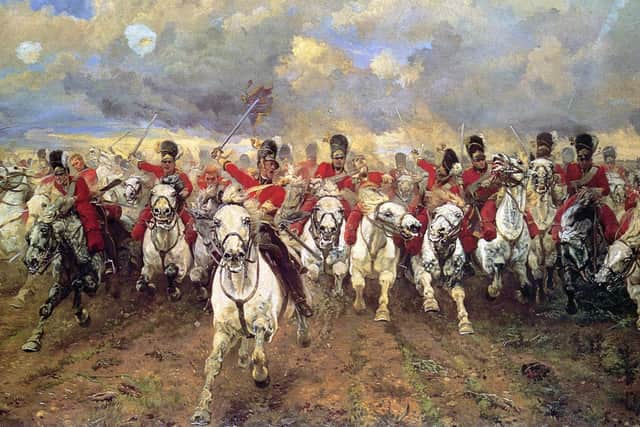It wasn't quite Scotland Forever! The indyref2 paper barely scraped a pass - John McLellan
If the 1881 painting took some liberties with historical accuracy ─ most of the horses were brown ─ Lady Butler can perhaps be forgiven given the battle was 66 years earlier, but the publication of the Scottish Government’s Wealthier, Happier, Fairer: Why Not Scotland? “scene-setter” paper has no such excuse. As a romanticised and selective paper for committed Nationalists it might scrape a pass, but not as the basis for serious analysis of Scotland’s undeniable under-performance. What it did spark was serious analysis of why the Scottish Government had produced such a weak paper, as if 50 pages of re-purposed graphs and cursory commentary would start to persuade doubters to end 300 years of stable and mutually beneficial partnership.
I wasn’t privy to a sneak preview when I predicted in last week’s column that the paper would be “short on detail and long on sound-bites; all the greener, fairer, healthier, and happier stuff from which few will demur”, but even I was surprised to see the usual vacuous buzz words were actually the title. The underwhelmed rection from some pro-independence commentators suggested the painting analogy would be more akin to Thomas Faed’s doleful The Last of the Clan. At least it has a grey horse.
Advertisement
Hide AdAdvertisement
Hide AdWhile SNP figures like former minister Marco Biagi, now consigned to life in opposition on Edinburgh Council, bemoaned negative press coverage, the reality is an uninspiring document, combined with First Minster Nicola Sturgeon’s unexpected admission that an independent Scotland in the EU would mean a hard trade border with England, meant bad headlines were guaranteed. Whether by accident or design ─ or deliberate misinformation ─ to regain some initiative, constitutional affairs secretary Angus Robertson’s seemingly unscripted announcement on the BBC’s Good Morning Scotland radio show that the intention was to hold a vote in October 2023 only added to the impression that the launch was either half-hearted or half-cocked.
But as this is like the first of a series to collect and keep, by the end the SNP hopes you will have a full Encyclopaedia Caledonia with all you need to know about how they think an independent Scotland will work which persuades you to vote for it. But for things like currency and borders the answers are already known because the core goal of a return to EU membership binds the prospectus into EU rules. It may be true the EU would welcome an independent Scotland with open arms, but on their terms and Brexit has demonstrated the lengths to which Europe will go to protect the single market, which in turn forced Ms Sturgeon to make her border controls concession. In backing the Northern Ireland protocol, Ms Sturgeon is actually strengthening the case for a hard land border with England as long as the rest of the UK is not aligned with EU rules. It’s only because lorries queue at Cairnryan for the Larne ferry that it’s not noticeable.
The example of Norway and Sweden is instructive, where non-EU Norway is a member of both the Schengen free travel area and the EU single market, and so complies with the bloc’s goods and trading standards. Controls between the two are as light touch as possible because of a historic open border policy going back to 1905 when the two nations separated amicably, but Norwegian customs data shows there are well over 200,000 physical vehicle checks a year ─ 240,760 in 2018 and 224,531 in 2019 ─ in a “control zone” 15km wide on either side of the border, complete with border posts fitted with number plate recognition cameras to trace suspected smugglers. Some 1,300 heavy goods vehicles are processed every day at the Svinesund crossing on the E6 motorway between Oslo and Gothenburg. The checkpoint is on the Swedish side, and for E6 read M6; the UK will no more fund, build or man customs at Carlisle than it will at Crossmaglen.


If a hard border is the price the SNP is prepared to pay for the promise of EU to woo middle class Remainers who voted No in 2014, that’s contradicted by the leadership’s new position of forgetting about a separate Scottish currency, a prerequisite for monetary control which EU candidacy demands. Ukraine, now on a faster track to membership, might only be surviving thanks to billions of pounds worth of UK and US armaments, but it has the hryvnia. Ms Sturgeon will never admit it, but her predecessor Alex Salmond is correct that these vote-losing conundra are only solvable by giving up on the EU and pursuing a Norway-style compromise. That might satisfy independence purists, but not Byers Road or Bruntsfield hipsters.
But it’s all hypothetical because it’s clearer than ever there is no legal route to a binding referendum without Westminster consent, which won’t happen while Conservatives, Labour and the Lib Dems are all opposed. Maybe Ms Sturgeon hopes dismay at Boris Johnson, public disquiet at Westminster blocking a referendum ─ a new study shows more than half agree the SNP has a mandate for a referendum, even if they don’t want one now ─ or unrest at rising prices can turn the next General Election into a referendum on a referendum and produce a result like Sinn Fein’s sweeping 1918 victory. But that’s now likely to be late 2024, a year beyond Mr Robertson’s promised timetable, and Mr Johnson could be gone in a fortnight after next week’s expected by-election drubbings.
No-one doesn’t want to be wealthier or happier, but the SNP’s answer is to paint a bleak picture and then sell a vision which makes us poorer and unhappier first. And this week’s paper had no answer to that.
Comments
Want to join the conversation? Please or to comment on this article.
